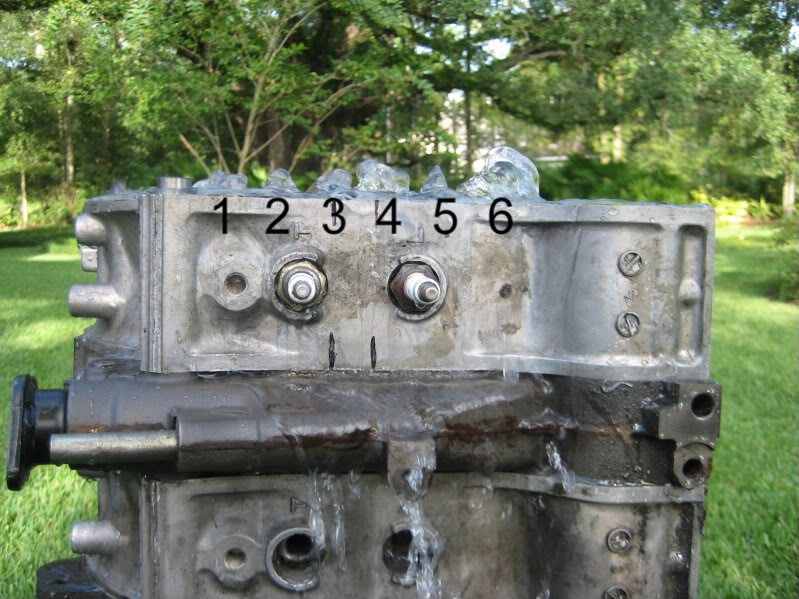Why Apex Seals Break
#1
Most people think that that their apex seal failures are caused by detonation. More specifically, they think the detonation was caused by some combination of poor fuel, advanced ignition, and high boost. This can and does happen but is not the root cause of the seal breakage.
One of my engines, which I thought would run a very long time because of reliability mods and low boost (14psi), lost an apex seal at about 30K miles. The only good news was that upon close examination I discovered a second apex seal in the set that was cracked but had not yet broken. (Sorry the magnification isn't better.)
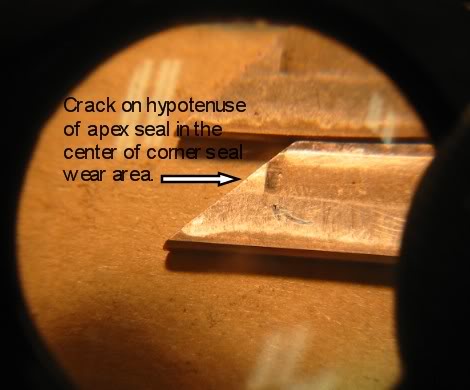
I was surprised to find crack was emanating from the bottom side not at the exposed working face!
It makes perfect sense. The main part of the seal is supported unevenly at three points. The forth spring contact point is on the wedge portion of the seal. When the seal rocks over the high point in the housing, specifically, the spark plug openings, the tip is under pressure from the wedge.
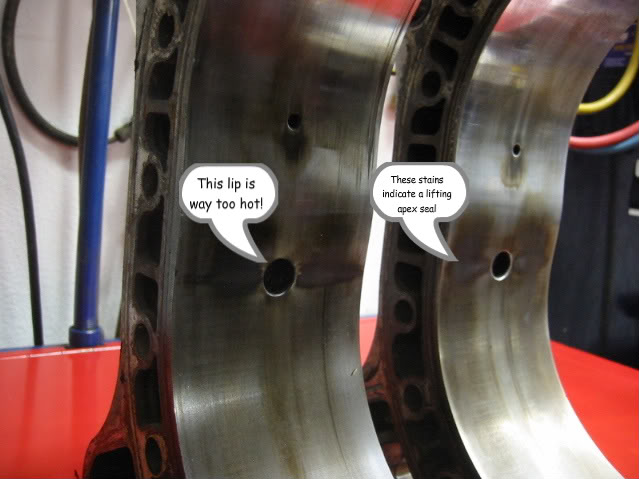 [/QUOTE]
[/QUOTE]
So you can try a little experiment to test this hypothesis. Install a .0015” feeler gauge at the center of the apex seal simulating the raised spark plug area. The seal will be rocked-over .003“ and the wedge will put pressure on the pointed end of the apex seal. Note the exaggerated condition depicted at the top of the picture.
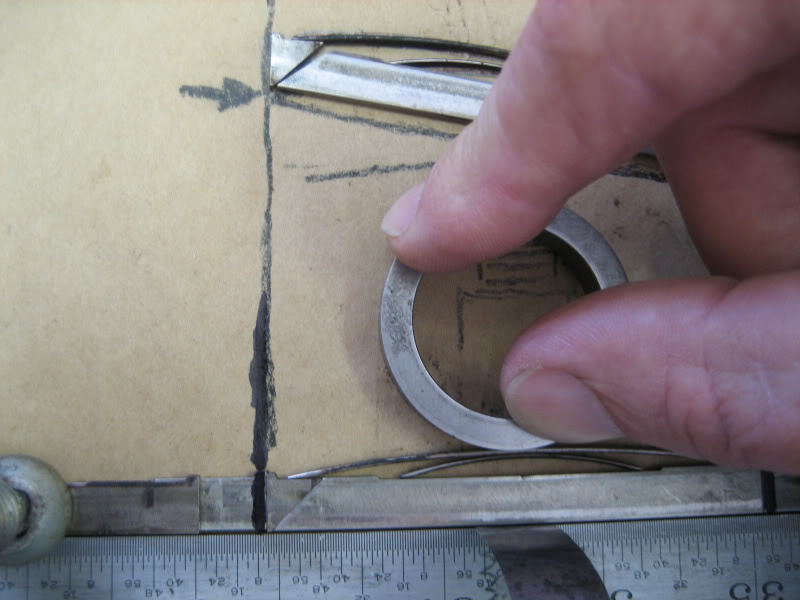
Barry Bordes
One of my engines, which I thought would run a very long time because of reliability mods and low boost (14psi), lost an apex seal at about 30K miles. The only good news was that upon close examination I discovered a second apex seal in the set that was cracked but had not yet broken. (Sorry the magnification isn't better.)

I was surprised to find crack was emanating from the bottom side not at the exposed working face!
It makes perfect sense. The main part of the seal is supported unevenly at three points. The forth spring contact point is on the wedge portion of the seal. When the seal rocks over the high point in the housing, specifically, the spark plug openings, the tip is under pressure from the wedge.
 [/QUOTE]
[/QUOTE]So you can try a little experiment to test this hypothesis. Install a .0015” feeler gauge at the center of the apex seal simulating the raised spark plug area. The seal will be rocked-over .003“ and the wedge will put pressure on the pointed end of the apex seal. Note the exaggerated condition depicted at the top of the picture.

Barry Bordes
#2
But we still haven’t gotten to the root cause. The real problem is the raised spark plug area on the housing. There are at least three approaches to this problem:
(1)- Use cold heat range plugs like NGK R7420-10 or 10.5. (This is easiest part of the solution.)
(2)-The harder second part is to cool the housing better.
A better pump is a good start. Second gen. cast impeller type pumps are a lot better or the Remedy pump for 3rd gens.
(3)-The most difficult part would be to port the housing in the spark plug area to minimize distortion.
But what is the best way?
The factory racing peripheral housing have a trough cast into the inner water jacket in this area but the are for NA applications.
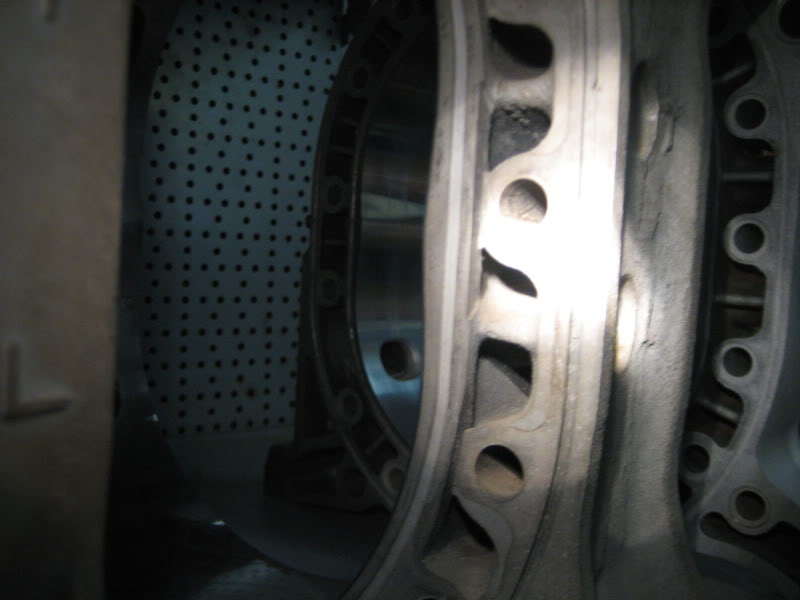
Notice that the thru-bolt bosses have been severed.
Barry
(1)- Use cold heat range plugs like NGK R7420-10 or 10.5. (This is easiest part of the solution.)
(2)-The harder second part is to cool the housing better.
A better pump is a good start. Second gen. cast impeller type pumps are a lot better or the Remedy pump for 3rd gens.
(3)-The most difficult part would be to port the housing in the spark plug area to minimize distortion.
But what is the best way?
The factory racing peripheral housing have a trough cast into the inner water jacket in this area but the are for NA applications.

Notice that the thru-bolt bosses have been severed.
Barry
#4
There is a dozen reasons why apexs break. I wouldn't call this the definitive answer.
I dont know if I would blame the force of the seal springs or deflection of the corner seal as much as blame the seal hitting that peak at high RPM.
There must have been some pre-ignition with that much hot gas leaking into the next cycle.
What plugs were you running?
I dont know if I would blame the force of the seal springs or deflection of the corner seal as much as blame the seal hitting that peak at high RPM.
There must have been some pre-ignition with that much hot gas leaking into the next cycle.
What plugs were you running?
#5
There is a dozen reasons why apexs break. I wouldn't call this the definitive answer.
I dont know if I would blame the force of the seal springs or deflection of the corner seal as much as blame the seal hitting that peak at high RPM.
I think we are saying the same thing here.
There must have been some pre-ignition with that much hot gas leaking into the next cycle.
The higher the peak of the more likely we will cause preignition.
What plugs were you running?
I dont know if I would blame the force of the seal springs or deflection of the corner seal as much as blame the seal hitting that peak at high RPM.
I think we are saying the same thing here.
There must have been some pre-ignition with that much hot gas leaking into the next cycle.
The higher the peak of the more likely we will cause preignition.
What plugs were you running?
RONIN,
Usually BUR9EQ all around. But I have tried 9's and iridium -10 trailing.
Do you think it is strange that the crack was starting on the bottom of the apex seal?
Barry
#6
Most people think that that their apex seal failures are caused by detonation. More specifically, they think the detonation was caused by some combination of poor fuel, advanced ignition, and high boost. This can and does happen but is not the root cause of the seal breakage.
One of my engines, which I thought would run a very long time because of reliability mods and low boost (14psi), lost an apex seal at about 30K miles. The only good news was that upon close examination I discovered a second apex seal in the set that was cracked but had not yet broken. (Sorry the magnification isn't better.)
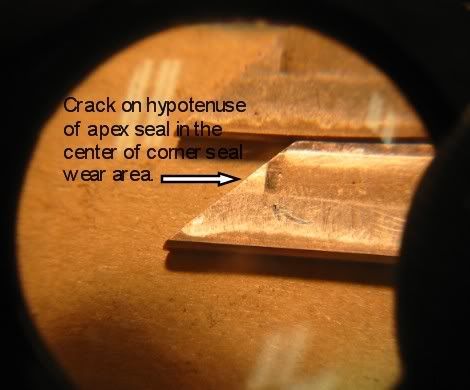
I was surprised to find crack was emanating from the bottom side not at the exposed working face!
It makes perfect sense. The main part of the seal is supported unevenly at three points. The forth spring contact point is on the wedge portion of the seal. When the seal rocks over the high point in the housing, specifically, the spark plug openings, the tip is under pressure from the wedge.
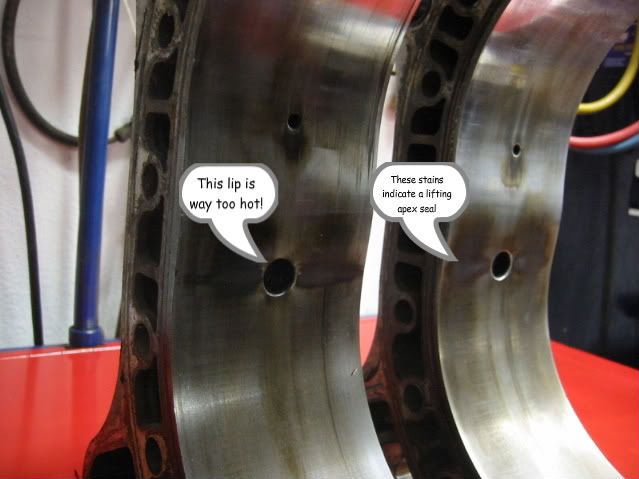
One of my engines, which I thought would run a very long time because of reliability mods and low boost (14psi), lost an apex seal at about 30K miles. The only good news was that upon close examination I discovered a second apex seal in the set that was cracked but had not yet broken. (Sorry the magnification isn't better.)

I was surprised to find crack was emanating from the bottom side not at the exposed working face!
It makes perfect sense. The main part of the seal is supported unevenly at three points. The forth spring contact point is on the wedge portion of the seal. When the seal rocks over the high point in the housing, specifically, the spark plug openings, the tip is under pressure from the wedge.

So you can try a little experiment to test this hypothesis. Install a .0015” feeler gauge at the center of the apex seal simulating the raised spark plug area. The seal will be rocked-over .003“ and the wedge will put pressure on the pointed end of the apex seal. Note the exaggerated condition depicted at the top of the picture.
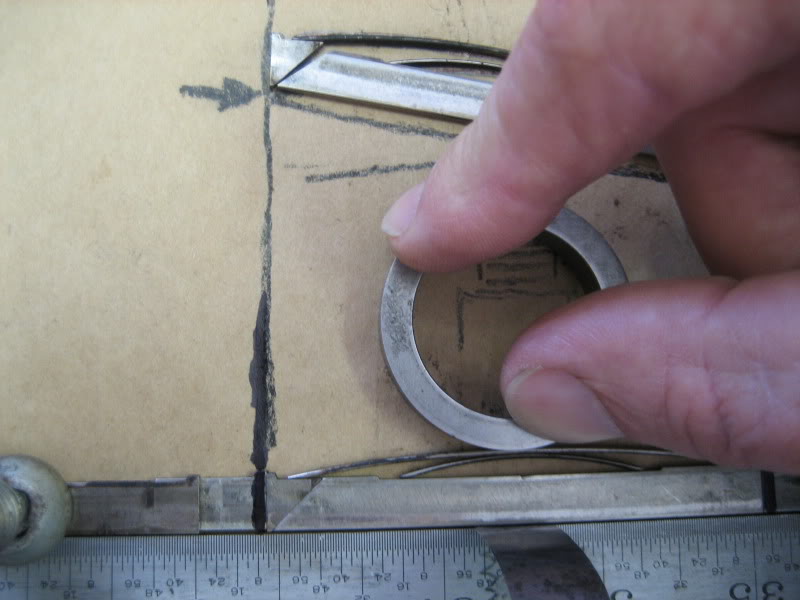
Barry Bordes
[/quote]
There is evidence of badly overheated spark plugs. The tubular column of aluminum that forms the spark plug hole complex in the housing has grown longer due to the heat. And yes this does deform the housing wall and raises it around the plug hole. After a long period of this complaint, there will be radial cracks around the leading plug hole, and usually a single horizontal crack through the trailing plug hole.
It would be a miracle if this engine was not detonating at high boost. So let us just cut to the chase, and say it was detonating, and then we must think that the Lambda sensor has reported to the controller that there is a problem and the controller has pulled out as much spark lead as it can and that apperarently is not enough to stop the problem. The gas leaks across the plugs are overheating the next charge and making another detonation event a sure thing.
The detonation events take place next to the apex seals next to the damage you have noted. The stock apex seals are really very strong and normally survive higher boost than you say these have been exposed to. Racing Beat and others offer a machining operation that cuts grooves around the spark plug bosses to increase the removal of heat into the coolant (more surface area).
The rotary with all of the units in operation have millions of hours operating at high boost numbers with a microscopic percentage of failures, so, just operating at high boost is not the e problem.
So, generally, a number of faults must be compiled to produce such damage. Since these engines are abused daily with no damage, the coolant flow, layout, volume, heat rejection rate, and radiator size I suggest is adequate. The short corner piece seals were not the very best for long life, and later seals have a long corner piece that does not damage the chrome as much. But even the short piece lasts quite a while in "normal" service. For hard use there are a number of alternative choices like a solid one piece seal. A Carbon seal, a ceramic one piece seal and a ceramic 2 piece seal. The solid seals require various amounts of end clearance to allow for the seal growth in length once up to temperature. This allows for some leakage during the warm up period. The 2 piece ceramic even eliminates that problem.
The gold standard for a high boost engine is the ceramic seal. (very pricy)
DETONATION:
an autoignition of the fuel air mixture, away from the spark plug and AFTER the planned ignition event. This was originated to explain the subject for a single plug piston engine, and the rotary has two plugs, and relatively speaking they are very far apart. But we continue. The fuel air mixture is ignited by heat. Be it the heat in an electrical arc in the spark gap of a spark plug
or the heat generated in some other activity. So, the first plug fires and the flame burns in all directions at a uniform rate based on mixture temperature. Say mixture temperature over and over.
As the flame burns through the chamber the pressure on all of the gasses goes up dramatically. And so the mixture far from the plug(s) is exposed for a longer time than the mixture that was close to the plug. The distant mixture is not only exposed to this pressure increase, but also to the radiant energy from the burning mixture, and once it reaches the needed temperature it ignites.
No problem right?
Well the problem is that since this bit of mixture is hundreds of degrees hotter than the mixture that was ignited next to the plug(s) and it is under hundreds of pounds more pressure. So its burn rate is that of an explosive. Let us guess that the burn rate is in thousands of feet per second, and the length of mixture to burn is one inch at each end of the rotor. So all ofthe remaining fuel is consumed in one thousandth of a second. So the first part of the burn is like a grass fire in a field, and the last bit is like a half stick of Dynamite. Enough power to spall bits of metal off the rotor face (those little pits)and crack apex seals, and shear off apex seals, and fracture corner seals, and other unhappy outcomes.
This detonation leaves extra heat in the rotor and housing, and adds to the possibility that another detonation event will follow.
No matter what the reason for fuel air charge temperature being to high, that charge temperature is the ONLY cause of detonation.
PREIGNITION:
An ignition event that occurs BEFORE the planned ignition event. This is likely to happen as a result of detonation overheating parts of the chamber like the plug ground straps glowing orange, or a sharp edge left behind, but can also be the stock igniters on older cars talking to each other. Or plug wires bundled together. Or if we think further along the intake system. Too much boost, making the intake charge too hot. But in every case the charge is ignited before the ignition system has fired.
Preignition can occur, and generate a detonation like event. But that will not fit into the Detonation definition if the event begins before the plug fires.
While an engine might survive occaisional detonation over a long period of use. It will not survive even a small number of preignition events. The rotor bearings will overheat, the dowels may shear off or the rear iron may crack open.
The engine trys to protect itself by reducing spark advance when the Lambda sensor feels the knock of a detonation event. Preignition may not, I suspect, trigger the sensor if no detonation is also present. Anumber of preignition events will soon include detonation, as the chamber temps go through the roof.
Also look for the apex seal groove to open up into a "V" shape.
Cooler charge (Bigger intercooler)bigger oil cooler, bigger radiator. Intake air from the cowl or in front of the radiator. water sprayed into the intake, on the radiator and intercooler. Onto the oil cooler and so-on. Higher octane fuel. Less ignition advance. No full throttle below power RPM. (looks like too much ignition advance). Plug wires well away from low voltage wires and each other. Ice cold spark plug heat range always................
Just my opinion. I could be wrong.
Lynn E. Hanover
#7
Thanks Lynn for your attention to this thread.
[/quote]
There is evidence of badly overheated spark plugs. The tubular column of aluminum that forms the spark plug hole complex in the housing has grown longer due to the heat. And yes this does deform the housing wall and raises it around the plug hole. After a long period of this complaint, there will be radial cracks around the leading plug hole, and usually a single horizontal crack through the trailing plug hole.
It would be a miracle if this engine was not detonating at high boost. So let us just cut to the chase, and say it was detonating, and then we must think that the Lambda sensor has reported to the controller that there is a problem and the controller has pulled out as much spark lead as it can and that apperarently is not enough to stop the problem. The gas leaks across the plugs are overheating the next charge and making another detonation event a sure thing.
The detonation events take place next to the apex seals next to the damage you have noted. The stock apex seals are really very strong and normally survive higher boost than you say these have been exposed to. Racing Beat and others offer a machining operation that cuts grooves around the spark plug bosses to increase the removal of heat into the coolant (more surface area).
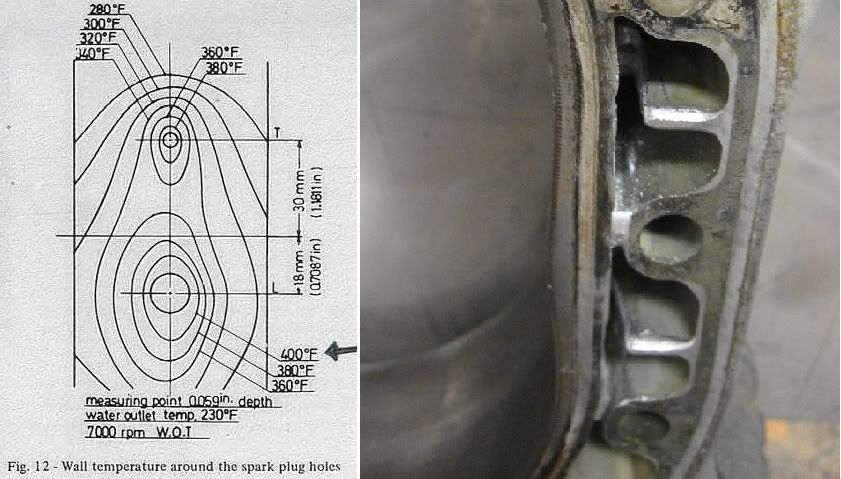
I think the swelling of the spark plug boss is an inherent problem with the rotary design and the one we may be able to correct or at least minimize it.
One thought, as shown in the above images, would be to sever the fins on the boss. This would still cool the plug boss but would allow the horizontally adjacent surfaces more heat. This might change the topographic like temperature hill to more of a step.
Barry Bordes
[/quote]
There is evidence of badly overheated spark plugs. The tubular column of aluminum that forms the spark plug hole complex in the housing has grown longer due to the heat. And yes this does deform the housing wall and raises it around the plug hole. After a long period of this complaint, there will be radial cracks around the leading plug hole, and usually a single horizontal crack through the trailing plug hole.
It would be a miracle if this engine was not detonating at high boost. So let us just cut to the chase, and say it was detonating, and then we must think that the Lambda sensor has reported to the controller that there is a problem and the controller has pulled out as much spark lead as it can and that apperarently is not enough to stop the problem. The gas leaks across the plugs are overheating the next charge and making another detonation event a sure thing.
The detonation events take place next to the apex seals next to the damage you have noted. The stock apex seals are really very strong and normally survive higher boost than you say these have been exposed to. Racing Beat and others offer a machining operation that cuts grooves around the spark plug bosses to increase the removal of heat into the coolant (more surface area).

I think the swelling of the spark plug boss is an inherent problem with the rotary design and the one we may be able to correct or at least minimize it.
One thought, as shown in the above images, would be to sever the fins on the boss. This would still cool the plug boss but would allow the horizontally adjacent surfaces more heat. This might change the topographic like temperature hill to more of a step.
Barry Bordes
#8
quote name='Lynn E. Hanover' date='29 October
Cooler charge (Bigger intercooler)bigger oil cooler, bigger radiator. Intake air from the cowl or in front of the radiator. water sprayed into the intake, on the radiator and intercooler. Onto the oil cooler and so-on. Higher octane fuel. Less ignition advance. No full throttle below power RPM. (looks like too much ignition advance). Plug wires well away from low voltage wires and each other. Ice cold spark plug heat range always................
Just my opinion. I could be wrong.
Lynn E. Hanover
[/quote]
My intake temps usually run only 4Cº above ambient at the most, even while boosting. I run a cool air duct/box and spray 50/50 water/meth both pre-turbo and post-intercooler.
It ran well for about 30K miles. Very low knock numbers (<20 on a PFC). Thought it would run forever with these and other reliability mods (some of them yours).
Barry
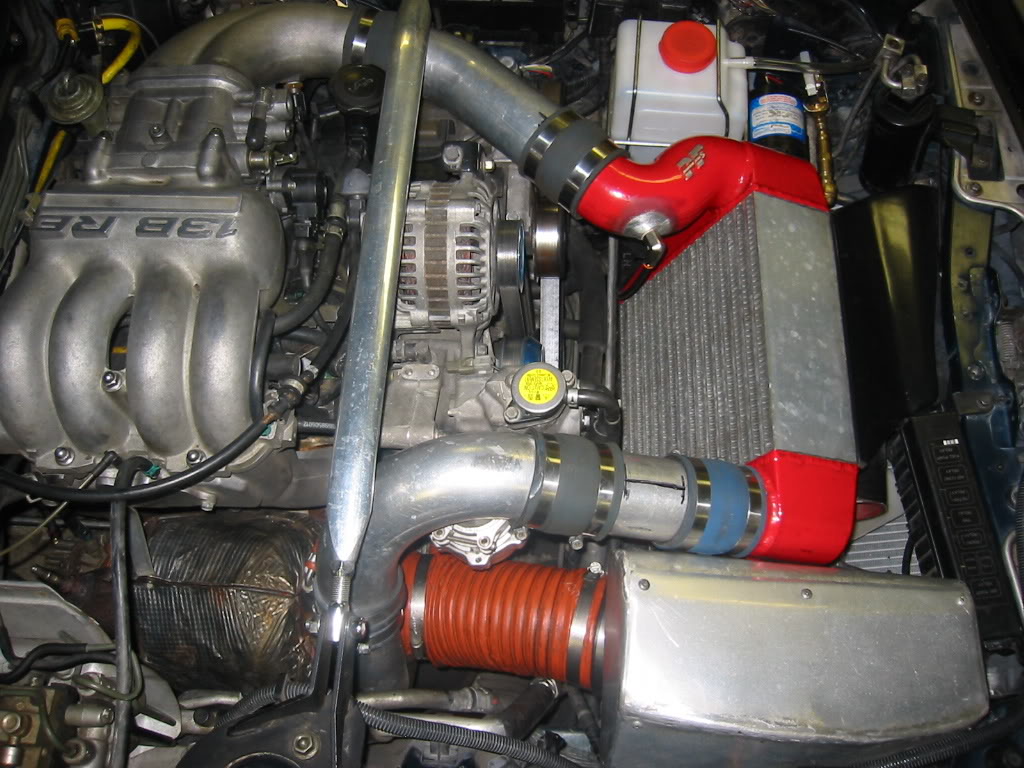
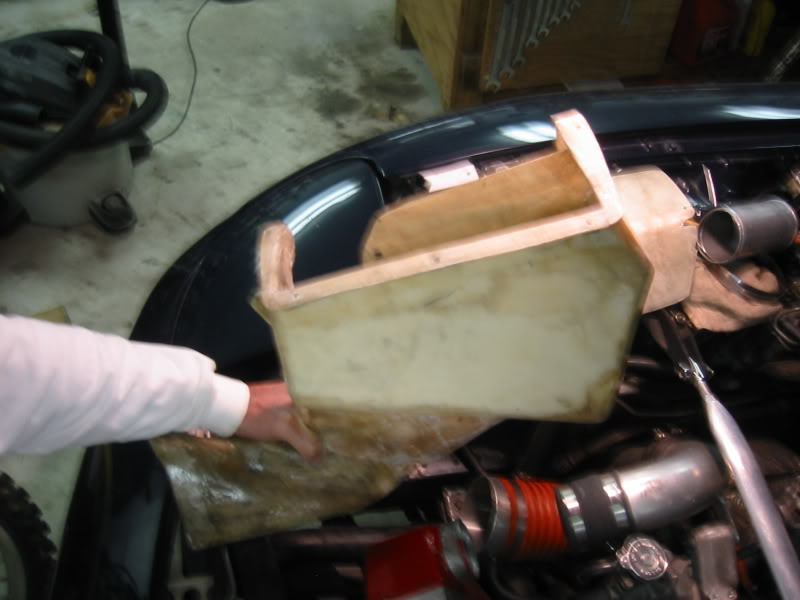
Cooler charge (Bigger intercooler)bigger oil cooler, bigger radiator. Intake air from the cowl or in front of the radiator. water sprayed into the intake, on the radiator and intercooler. Onto the oil cooler and so-on. Higher octane fuel. Less ignition advance. No full throttle below power RPM. (looks like too much ignition advance). Plug wires well away from low voltage wires and each other. Ice cold spark plug heat range always................
Just my opinion. I could be wrong.
Lynn E. Hanover
[/quote]
My intake temps usually run only 4Cº above ambient at the most, even while boosting. I run a cool air duct/box and spray 50/50 water/meth both pre-turbo and post-intercooler.
It ran well for about 30K miles. Very low knock numbers (<20 on a PFC). Thought it would run forever with these and other reliability mods (some of them yours).
Barry


#9
Hi!: even when old work by Yanmar Diesel and Sachs in their small RCEs pointed that rounding intersection of plug hole to housing working surface added carbon deposits there leading to pre-ignition, it seems intuitive that rounding the plug hole would reduce the 'knock' seals get every time it pass over the plug hole, and also Toyota obtained a 7% improvement in fuel economy by substituting a glow plug instead of the spark plug in the leading site. (SAE papers Toyota 790435 and Mazda 780417)
Old leaded gasolines had a self-lubricating effect, reducing wear and prolonging engine life, effect lost in unleaded gas, thus, some advise always directly adding 1% of lubricating oil to gasoline in tank; alcohol-gasoline mixes, according to SAE papers by Syvaro and Total, reduce thermal load and emissions, and improve fuel economy.
Any comment about the feasibility of rounding the plug hole corners, or somebody having tested it?
Suzuki RE-5 had ferrotic apex seals, is there somebody selling Ferrotic apex seals for Mazdas today, or the so called: 'ceramic' seals are actually made of ferrotic?
Thanks, + salut
Old leaded gasolines had a self-lubricating effect, reducing wear and prolonging engine life, effect lost in unleaded gas, thus, some advise always directly adding 1% of lubricating oil to gasoline in tank; alcohol-gasoline mixes, according to SAE papers by Syvaro and Total, reduce thermal load and emissions, and improve fuel economy.
Any comment about the feasibility of rounding the plug hole corners, or somebody having tested it?
Suzuki RE-5 had ferrotic apex seals, is there somebody selling Ferrotic apex seals for Mazdas today, or the so called: 'ceramic' seals are actually made of ferrotic?
Thanks, + salut


